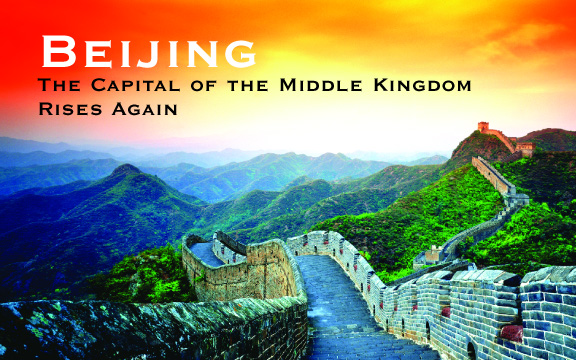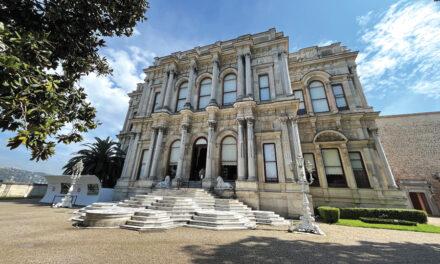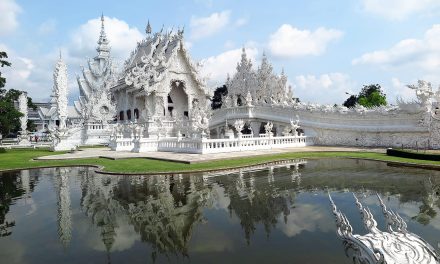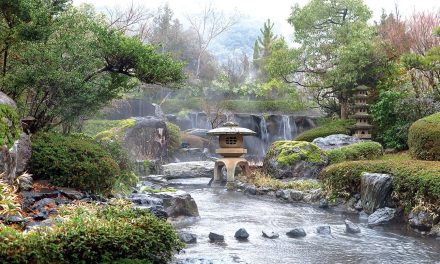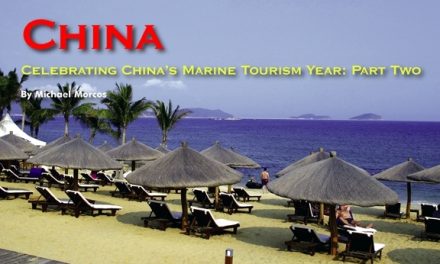Beijing
The Capital of The Middle Kingdom Rises Again
By Habeeb Salloum
E-mail: habeeb.salloum@sympatico.ca
Published in the September, 2004 Issue of Canadian World Traveller
Photos by Habeeb Salloum & Courtesy of China National Tourist Office www.tourismchina-ca.com
I’m only staying for four days. How can I see a huge city in such a short time? I don’t know where to start! Frustrated thinking of what to do, I asked Lin, a Hong Kong businessman who had travelled to Beijing many times. He smiled, “There’s no problem! For the first day join an organized tour of the city; for the second day take an excursion to the Great Wall; for the third day tour the Forbidden City; and for the last day, explore the Old City by foot and rickshaw.” He continued, “This will give you an idea of Chinese history. Remember! We are an ancient nation that, in the past, our people used to call the Middle Kingdom and believed that the emperor was the Son of Heaven and our land was the centre of the universe.”
Following his advice, the next morning I was on a bus touring the city. Of course, this was to be only a superficial exploration. The sprawling 13 million city, more than 160 km (100 miles) in each direction needs much more time to discover.
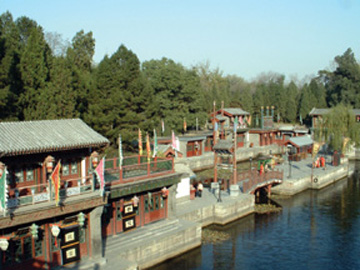 Summer Palace
Summer Palace
We toured the newer sections with their sky-reaching skyscrapers and wide avenues, no different than the modern cities in the West. Our first historical stop was the Summer Palace on the outskirts of the city. The best preserved large imperial garden, edging the Kunming man-made lake, it is one of the most famous royal gardens in the world. It is noted for its 700 m (2,300 ft) Long Corridor filled with mythical paintings and scenes and for its main building, the Hall of Benevolence and Longevity. For an hour we roamed through its huge complex of courtyards, residences and temples, then lunched in one of its fine dining places. To us, it appeared to be a fairy-tale from the past come true.
Yonghe Lamasery Temple
Our next stop was the Yonghe Lamasery Temple, a sprawling complex of structures which were crowded with worshippers. The most famous lamasery in China, it is the most colorful temple in the city. The most renowned Tibetan Buddhist temple outside Tibet, it was once the official residence of Count Yin Zhen who, when promoted to emperor, moved to the Forbidden City and his palace was converted into a lamasery.
From the lamasery, we drove to the Temple of Heaven, nestled in a huge park. It was built in 1420 for the emperor to pray for good harvests. Its main attraction, the ‘Hall of Prayer for Good Harvests’ is considered to be the epitome of sacred Chinese architecture.
Great Wall
Feeling excitement, early next morning we were on our way to the Great Wall – China’s proud trademark. As our tour bus approached the Badaling section of the Wall – to tourists, the most famous part due to its proximity to Beijing. I became elated. A life-long ambition was soon to be fulfilled.
Turning and twisting, the Great Wall averages in most places 8 m (26 ft) high and 6m (20 ft) wide and was once crowned with some 25,000 towers. Like a giant snake, it winds its way for 6,000 km (3,750 miles) from east to west through five provinces, running along high mountain ridges, valleys, deserts and grasslands and was built as a defense barrier to ward off tribal nomads from the north.
Reaching the top of the Wall, I surveyed the scene I felt that my painful climb had been worthwhile. From my vantage point, I got a good feel as to what climbing the wall was all about. It was a clear autumn day and I was able to admire a breathtaking view of the golden landscape, a perfect scene for an artist’s brush. I felt contentment as I was soothed by the cool breezes while I relished the picture postcard view.
On our way back to Beijing, when discussing the Wall and Chinese history our guide summed it all up as he philosophized, “The Wall was built to keep out the Barbarians from the north, but today its function has changed. It is drawing visitors from the four corners of the globe to gaze on the handiwork of our forefathers. Imagine, our ancestors are still helping us draw in the dollars.”
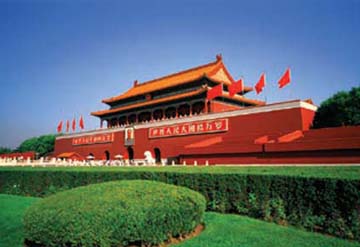 Forbidden City
Forbidden City
On the third day, we entered the Forbidden City from the 44 ha (109 acres) Tiananmen Square, considered the largest city square in the world. Situated in the heart of Beijing, this royal City is a symbol of Chinese history. In the last decade, it has been totally restored and is now ready for the expected rush of tourists during the Summer Olympics in 2008. Once forbidden to all except the emperor, and the 30,000 court officials, including 10,000 eunuchs and servants, it was first built by the 13th century Mongol emperors and enhanced by later dynasties.
Inside its once secret walls are the largest and best preserved historic structures in China. Its splendid complex of 800 buildings with their 9,999 rooms (to the Chinese, number 9 represents longevity), courtyards and gardens, crowned by the Royal Palace, housing 900,000 priceless antiques, was the nerve centre of the empire from where royal decrees would be delivered beyond the walls by powerful court officials.
Pu Yi, the last emperor, left the palace in 1924. Today, it has been turned into a breathtaking museum – the setting for the Oscar-winning film, ‘The Last Emperor’.
 Imperial Palace
Imperial Palace
As we moved through the pavilions of the Imperial Palace, I could almost visualize beautiful concubines and proud emperors with their eunuchs strolling through its courtyards, lush gardens and great halls. The area of the palace is huge, 72 ha (178 acres), that after walking for hours, we could only explore a part of the palace complex, but the enormity and magnificence of what we saw left us amazed.
Old Beijing
Feeling fulfillment after the three days of touring, for the last day with an English-speaking guide, I set out by foot and rickshaw to discover the traditional Hutongs (a Mongolian word meaning narrow alleyways). Beyond the modern skyscrapers, malls and luxury hotels, they are a reminder of Old Beijing.
Intriguing in their appeal to tourists, they are lined with old courtyard style homes and appealing yellow-tiled temples, bringing to life the city’s long cultural history. It was like walking into the world of long ago – the time when the Chinese believed that China was the centre of the world and, of course, minus the modern pollution. Sadly, many of these homes are now being bulldozed to make way for modern plazas and sky-reaching structures.
Modern Metropolis
The world of progress with its modern roadways, towering skyscrapers and traffic jams is taking over. The old has gradually given way to the new. Government officials want to turn Beijing, a city of some 13 million, into a modern international metropolis before 2008 when the city will host the Summer Olympics and again becomes the centre of the world.
At that time when visitors are expected to come in the millions, taking our 4-day historic excursion will leave an indelible mark on their minds. It will be a whirlwind discovery of China and its culture with the venerable sites of Beijing playing a major role.
Other Historic Places
Other important historic places to see include the Ming Tombs, located some 50 km (31 miles) north of Beijing where 13 of the 16 Ming Emperors are buried. After walking through a lyrical willow-lined avenue called the Sacred Way, lined with stone statues of animals and court officials, one enters the only excavated tomb, that of Zhu Yijun and his two wives.
If time permits, one should also visit the Museum of Chinese History, located on the edge of Tiananmen Square; the White Cloud Taoist Temple, the largest Taoist temple in Beijing; the Sleeping Buddha Temple, noted for its 5 m (16 ft) statue of Sakyamuni; the Buddha.
Tanzhe Temple and its famed pagoda gardens; and the Fragrant Hills, once an imperial garden for the emperors.
Currency & Exchange
The currency of China, the RMB or Yuan, is currently valued at about 8.2 to the U.S. dollar; and 6.5 to the Canadian dollar. Conversion of foreign currency can be done in banks or hotels. China is one of the few countries in the world where hotels give the same rates as the banks. The exchange rate for travellers cheques is more favorable than that for cash. Also, most credit cards are accepted.
Visas & Health
All foreigners travelling to China must apply to a local Chinese embassy or consulate for tourist visas. A 90 Yuan airport departure tax is collected from passengers departing from any international airport in China – domestic flights 50 Yuans. Only some tap water in China is potable. However, bottled mineral water is on sale everywhere.
Getting Around
Taxi fares in China are always clearly marked on the taxi window. Most taxi drivers do not understand much English. Hence, visitors should have their destinations written down by a hotel clerk in Chinese and show the written destination to the cab driver. Public transportation in Beijing is cheap and plentiful – cost – subways 3 Yuans and buses 1 Yuan. Taxis from airport to city around 100 Yuans.
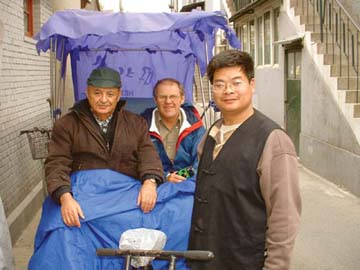 About the Author
About the Author
Habeeb Salloum is a freelance writer, author and member of Travel Media Association of Canada (TMAC) residing in Toronto, Canada. He has travelled extensively to most parts of the world and has written comprehensively about topical items, tourism and the cuisines of the countries through which he has journeyed. Many of his writings can be found on the internet. The best search engine to use would be Google, using the search words “Habeeb Salloum”. E-mail: habeeb.salloum@sympatico.ca
Photo: Author Habeeb Salloum (on left) having rickshaw ride in the Hutong District of Beijing.
For More Info:
China National Tourist Office
480 University Ave., Suite 806
Toronto, ON M5G 1V2
Toll-Free: 1-866-599-6636
Fax: 416-599-6382
E-mail: cnto@tourismchina-ca.com
www.tourismchina-ca.com
Embassy of the People’s Republic of China
515 St. Patrick Street,
Ottawa, ON K1N 5H3
Tel.: (613) 7893434
Fax: 613-7891911
E-mail: chinaemb_ca@mfa.gov.cn
www.chinaembassycanada.org/eng/
Cathay Pacific Airways
Lester B Pearson International Airport, Terminal 3
PO Box 59,
Toronto AMF, ON L5P 1A2
Toll-Free: 1-800-268-6868
E-mail: See Website
www.cathay.ca

